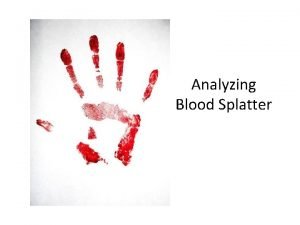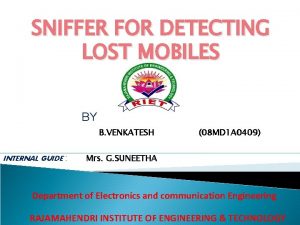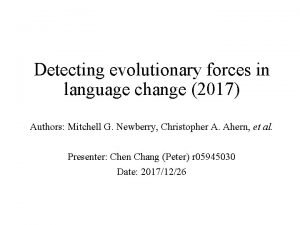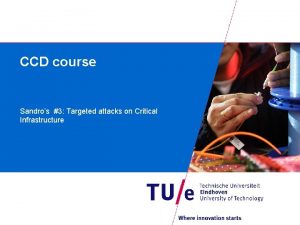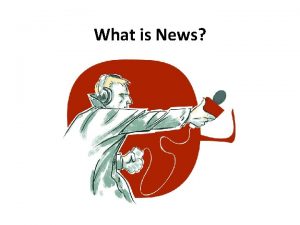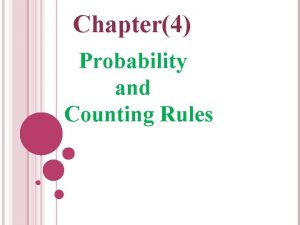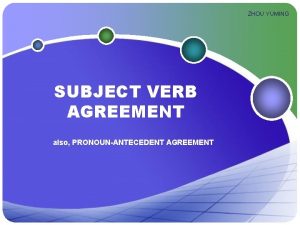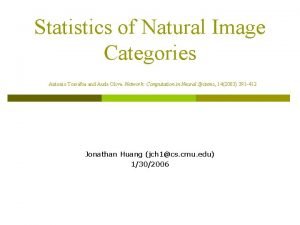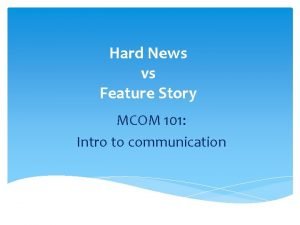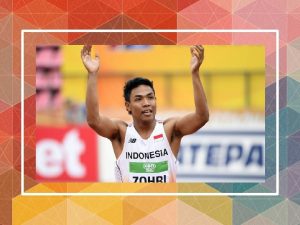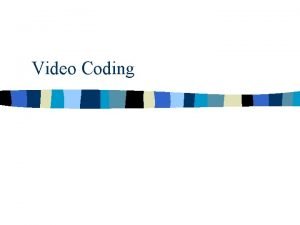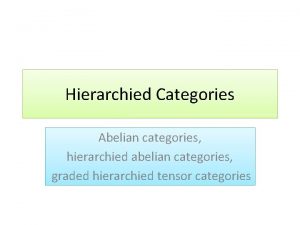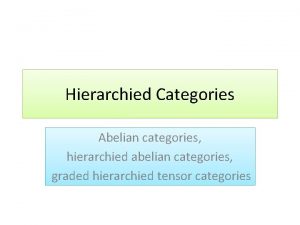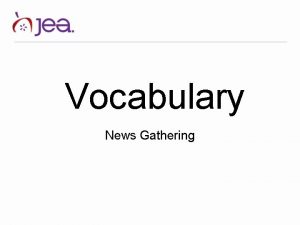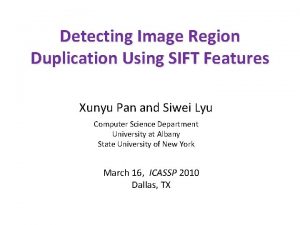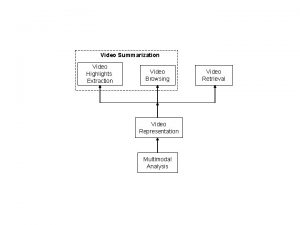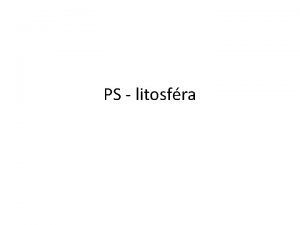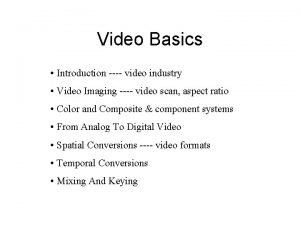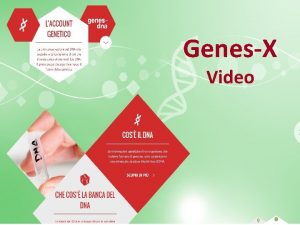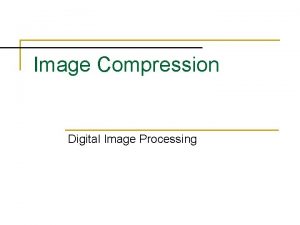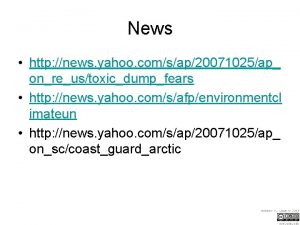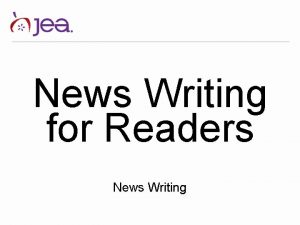Detecting Categories in News Video Using Image Features






![[Berg & Malik, CVPR’ 01] Geometric Blur (Local Appearance Descriptor) Compute sparse channels from [Berg & Malik, CVPR’ 01] Geometric Blur (Local Appearance Descriptor) Compute sparse channels from](https://slidetodoc.com/presentation_image_h/8d3f7b10e7c303540d97e71c075d6a40/image-7.jpg)

![[Berg, Berg & Malik, CVPR’ 05] Comparing Images § Sample 200 GB features from [Berg, Berg & Malik, CVPR’ 05] Comparing Images § Sample 200 GB features from](https://slidetodoc.com/presentation_image_h/8d3f7b10e7c303540d97e71c075d6a40/image-9.jpg)

![[Zhang, Berg, Maire & Malik, CVPR’ 06] Caltech 101 Results uses GB features [Zhang, Berg, Maire & Malik, CVPR’ 06] Caltech 101 Results uses GB features](https://slidetodoc.com/presentation_image_h/8d3f7b10e7c303540d97e71c075d6a40/image-11.jpg)







- Slides: 18

Detecting Categories in News Video Using Image Features Slav Petrov, Arlo Faria, Pascal Michaillat, Alex Berg, Andreas Stolcke, Dan Klein, Jitendra Malik

System Overview Images GB SVM ASR MFCC TFIDF GMM Sequential context Audio Category correlation Video Source combination 1 -best selection SVM Feature extraction Primary systems Higher-level systems

Image Features in Trec. Vid ’ 05 § IBM: § Color Histogram § Color Correlogram § Color Moments § Co-occurence Texture § Wavelet Texture Grid § Edge Histogram Layout § CMU (local): § Color Histograms (in different color spaces) § Texture Histograms § Edge Histograms § Columbia (part based model): § Color § Texture § Size § Spatial Relation § Tsinghua (local and global): § Color Auto-Correlograms § Color Coherence Vectors § Color Histograms § Color Moments § Edge Histograms § Wavelet Texture

Image Features in Trec. Vid ’ 05 Berkeley Tsinghua Columbia CMU IBM Moments Color Correlograms Histograms Texture Wavelets Edge Histograms Shape

Exemplars for Recognition § Use exemplars for recognition § Compare query image and each exemplar using shape cues Database of Exemplars Query Image

Finding similar patches Exemplar Query
![Berg Malik CVPR 01 Geometric Blur Local Appearance Descriptor Compute sparse channels from [Berg & Malik, CVPR’ 01] Geometric Blur (Local Appearance Descriptor) Compute sparse channels from](https://slidetodoc.com/presentation_image_h/8d3f7b10e7c303540d97e71c075d6a40/image-7.jpg)
[Berg & Malik, CVPR’ 01] Geometric Blur (Local Appearance Descriptor) Compute sparse channels from image ~ Geometric Blur Descriptor is robust to Descriptor small affine distortions Extract a patch in each channel Idealized signal Apply spatially varying blur and sub-sample

GB in Practice § In practice compute discrete blur levels for whole image and sample as needed for each feature location. Horizontal Channel Vertical Channel Increasing Blur
![Berg Berg Malik CVPR 05 Comparing Images Sample 200 GB features from [Berg, Berg & Malik, CVPR’ 05] Comparing Images § Sample 200 GB features from](https://slidetodoc.com/presentation_image_h/8d3f7b10e7c303540d97e71c075d6a40/image-9.jpg)
[Berg, Berg & Malik, CVPR’ 05] Comparing Images § Sample 200 GB features from edge points § Dissimilarity from A to B is where the Fx are the GB features.

Caltech 101 Dataset § Object Recognition Benchmark § 101 Categories: § § Stereotypical pose Little clutter Objects centered One object per image
![Zhang Berg Maire Malik CVPR 06 Caltech 101 Results uses GB features [Zhang, Berg, Maire & Malik, CVPR’ 06] Caltech 101 Results uses GB features](https://slidetodoc.com/presentation_image_h/8d3f7b10e7c303540d97e71c075d6a40/image-11.jpg)
[Zhang, Berg, Maire & Malik, CVPR’ 06] Caltech 101 Results uses GB features

Primal features for SVM § Compare to 50 prototypes from each class § Use distances as feature vector for an SVM Query Prototype s Featur 0. 7 e Vector … . . . 0. 9 … 0. 1 … …… 0. 8 ………. 0. 7

SVM features interpretation § Slices of the Kernel Matrix: q § Fixed-points in a higher dimensional vector space: ti tj tk ti tj q tk

SVM Specifics § SVMlight package § Same parameters for all categories: § Linear kernel § Default regularization parameter § Asymmetric cost doubling the weight of positive examples

m. AP = 0. 11 Co TV mpu -Sc ter ree n Ca r eti ng Me Sp ort s Results ’ 06 Results ’ 05 Berkeley-Shape m. AP = 0. 38 Best ’ 05 (IBM) m. AP = 0. 34 Best Berkeley-Shape Median

Limitations § Several objects per image: § Features do not capture: § Different Scales § Color

Conclusions § Shape is an important cue for object recognition. § System that uses shape features only can have competitive performance. § Shape features are orthogonal to features used in the past.

Thank You! petrov@eecs. berkeley. edu
 Search for an image using an image
Search for an image using an image Sniffer for detecting lost mobiles
Sniffer for detecting lost mobiles Detecting evolutionary forces in language change
Detecting evolutionary forces in language change Kerberos golden ticket detection
Kerberos golden ticket detection How do fraud symptoms help in detecting fraud
How do fraud symptoms help in detecting fraud Havex
Havex Soft news
Soft news A television news director wishes to use three news stories
A television news director wishes to use three news stories All that glitters ______ not gold
All that glitters ______ not gold Statistics of natural image categories
Statistics of natural image categories Videoyandex
Videoyandex Gravity yahoo
Gravity yahoo Video.search.yahoo.com
Video.search.yahoo.com The frame size of a video refers to the video’s
The frame size of a video refers to the video’s To inform the readers/listeners about a newsworthy event.
To inform the readers/listeners about a newsworthy event. Feature story writing
Feature story writing News item text adalah
News item text adalah Sports news in passive voice
Sports news in passive voice Hevc full form
Hevc full form
